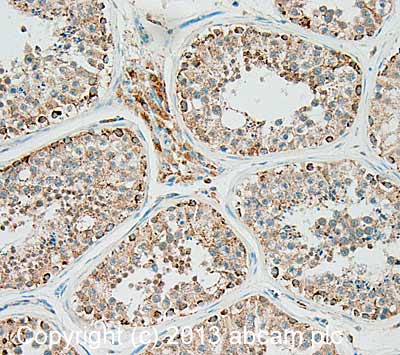Anti-DKKL1 antibody (ab110800)
Key features and details
- Rabbit polyclonal to DKKL1
- Suitable for: IHC-P, WB
- Reacts with: Human
- Isotype: IgG
Overview
-
Product name
Anti-DKKL1 antibody -
Description
Rabbit polyclonal to DKKL1 -
Host species
Rabbit -
Tested Applications & Species
See all applications and species dataApplication Species IHC-P HumanWB Human -
Immunogen
Synthetic peptide. This information is proprietary to Abcam and/or its suppliers.
-
Positive control
- This antibody gave a positive signal in Human Testis tissue lysate. This antibody gave a positive result in IHC in the following FFPE tissue: Human normal testis.
Properties
-
Form
Liquid -
Storage instructions
Shipped at 4°C. Store at +4°C short term (1-2 weeks). Upon delivery aliquot. Store at -20°C or -80°C. Avoid freeze / thaw cycle. -
Storage buffer
pH: 7.40
Constituent: 0.02% PBS buffer
Batches of this product that have a concentration Concentration information loading...
Concentration information loading...Purity
Immunogen affinity purifiedClonality
PolyclonalIsotype
IgGResearch areas
Associated products
-
Compatible Secondaries
-
Isotype control
Applications
The Abpromise guarantee
Our Abpromise guarantee covers the use of ab110800 in the following tested applications.
The application notes include recommended starting dilutions; optimal dilutions/concentrations should be determined by the end user.
GuaranteedTested applications are guaranteed to work and covered by our Abpromise guarantee.
PredictedPredicted to work for this combination of applications and species but not guaranteed.
IncompatibleDoes not work for this combination of applications and species.
Application Species IHC-P HumanWB HumanAll applications ChimpanzeeMacaque monkeyGorillaOrangutanApplication Abreviews Notes IHC-P Use a concentration of 5 µg/ml. Perform heat mediated antigen retrieval with citrate buffer pH 6 before commencing with IHC staining protocol.WB Use a concentration of 1 µg/ml. Detects a band of approximately 32 kDa (predicted molecular weight: 27 kDa).Notes IHC-P
Use a concentration of 5 µg/ml. Perform heat mediated antigen retrieval with citrate buffer pH 6 before commencing with IHC staining protocol.WB
Use a concentration of 1 µg/ml. Detects a band of approximately 32 kDa (predicted molecular weight: 27 kDa).Target
-
Sequence similarities
To the N-terminal section of DKK-3. -
Post-translational
modificationsN-glycosylated. -
Cellular localization
Secreted. - Information by UniProt
-
Database links
- Entrez Gene: 27120 Human
- Omim: 605418 Human
- SwissProt: Q9UK85 Human
- Unigene: 515855 Human
-
Alternative names
- Cancer/testis antigen 34 antibody
- CT34 antibody
- dickkopf like 1 antibody
see all
Images
-
 Immunohistochemistry (Formalin/PFA-fixed paraffin-embedded sections) - Anti-DKKL1 antibody (ab110800)
Immunohistochemistry (Formalin/PFA-fixed paraffin-embedded sections) - Anti-DKKL1 antibody (ab110800)IHC image of DKKL1 staining in Human normal testis formalin fixed paraffin embedded tissue section, performed on a Leica Bond™ system using the standard protocol F. The section was pre-treated using heat mediated antigen retrieval with sodium citrate buffer (pH6, epitope retrieval solution 1) for 20 mins. The section was then incubated with ab110800, 5µg/ml, for 15 mins at room temperature and detected using an HRP conjugated compact polymer system. DAB was used as the chromogen. The section was then counterstained with haematoxylin and mounted with DPX.
For other IHC staining systems (automated and non-automated) customers should optimize variable parameters such as antigen retrieval conditions, primary antibody concentration and antibody incubation times.
-
Anti-DKKL1 antibody (ab110800) at 1 µg/ml + Testis (Human) Tissue Lysate - adult normal tissue at 20 µg
Secondary
Goat Anti-Rabbit IgG H&L (HRP) (ab97051) at 1/10000 dilution
Developed using the ECL technique.
Performed under reducing conditions.
Predicted band size: 27 kDa
Observed band size: 32 kDa why is the actual band size different from the predicted?
Additional bands at: 70 kDa (possible non-specific binding)
Exposure time: 8 minutesDKKL1 contains a number of potential glycosylation sites (SwissProt) which may explain its migration at a higher molecular weight than predicted.
This blot was produced using a 10% Bis-tris gel under the MOPS buffer system. The gel was run at 200V for 50 minutes before being transferred onto a Nitrocellulose membrane at 30V for 70 minutes. The membrane was then blocked for an hour using 5% Bovine Serum Albumin before being incubated with ab110800 overnight at 4°C. Antibody binding was detected using an anti-rabbit antibody conjugated to HRP, and visualised using ECL development solution.
Protocols
Datasheets and documents
References (0)
ab110800 has not yet been referenced specifically in any publications.
Images
-
 Immunohistochemistry (Formalin/PFA-fixed paraffin-embedded sections) - Anti-DKKL1 antibody (ab110800)
Immunohistochemistry (Formalin/PFA-fixed paraffin-embedded sections) - Anti-DKKL1 antibody (ab110800)IHC image of DKKL1 staining in Human normal testis formalin fixed paraffin embedded tissue section, performed on a Leica Bond™ system using the standard protocol F. The section was pre-treated using heat mediated antigen retrieval with sodium citrate buffer (pH6, epitope retrieval solution 1) for 20 mins. The section was then incubated with ab110800, 5µg/ml, for 15 mins at room temperature and detected using an HRP conjugated compact polymer system. DAB was used as the chromogen. The section was then counterstained with haematoxylin and mounted with DPX.
For other IHC staining systems (automated and non-automated) customers should optimize variable parameters such as antigen retrieval conditions, primary antibody concentration and antibody incubation times.
-
Anti-DKKL1 antibody (ab110800) at 1 µg/ml + Testis (Human) Tissue Lysate - adult normal tissue at 20 µg
Secondary
Goat Anti-Rabbit IgG H&L (HRP) (ab97051) at 1/10000 dilution
Developed using the ECL technique.
Performed under reducing conditions.
Predicted band size: 27 kDa
Observed band size: 32 kDa why is the actual band size different from the predicted?
Additional bands at: 70 kDa (possible non-specific binding)
Exposure time: 8 minutesDKKL1 contains a number of potential glycosylation sites (SwissProt) which may explain its migration at a higher molecular weight than predicted.
This blot was produced using a 10% Bis-tris gel under the MOPS buffer system. The gel was run at 200V for 50 minutes before being transferred onto a Nitrocellulose membrane at 30V for 70 minutes. The membrane was then blocked for an hour using 5% Bovine Serum Albumin before being incubated with ab110800 overnight at 4°C. Antibody binding was detected using an anti-rabbit antibody conjugated to HRP, and visualised using ECL development solution.









